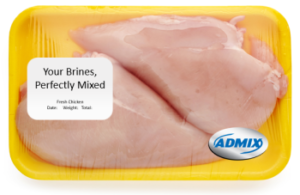Written by Allen Dawson, Meat & Poultry Market Manager
 Working in meat & poultry plants for more than twenty years, I have learned that minor inconsistencies can cause major problems when it comes to making brine batches.
Working in meat & poultry plants for more than twenty years, I have learned that minor inconsistencies can cause major problems when it comes to making brine batches.
My advice for avoiding the problems is to follow my nine rules of thumb, one of which is to keep your Formulation Spec Sheet handy when making and preparing brine batches. Mixing is without a doubt, the most important step in any brine, marination, batter or breading line. Low flow and low intensity mixing is often another pitfall, and one that the Admix Rotosolver RXRS can help you avoid.
Here are nine basic rules of thumb for successfully mixing brines:
- Assign your most detail-oriented team member to lead your mixing operation because even slight variations can cause major problems and waste.
- Use soft water. Master Butcher, Mr. Wolf Ludwig, who was my mentor, was inducted into the Meat Hall of Fame in 2015, always told me that water hardness needed to be less than 100 ppm for adequate quality. He liked to have a water hardness of less than 60 ppm. Many plants now have only one water source and water softening systems to get better water quality.
- Make sure all valves and caps that drain the tank are sealed and closed.
- Pull out your Formulation Spec Sheet and find the product you are about to run. Ensure you add the right amount of water. If you are using ice to cool your brine down, be sure to add it to the weight of the total amount of water needed. Ice can be added directly to the tank while running the Rotosolver RXRS!
- Zero out the water meter and turn on the water – unless you have a water leveling device, do not leave the tank before it is full. I have seen plants that let the water run over the sides of the tank until they are ready to make a batch. This is a real waste of resources and causes more time to prepare the batch due to having to drain back the water to the correct level.
- This is the most important part of mixing brine – turn on your Admix Rotosolver RXRS because you are now you are ready to add the ingredients. Refer to the Formulation Spec Sheet once again, ensuring the ingredient amounts are followed to the letter. We will assume the ingredients to be mixed are water, salt, tri-poly phosphate, and split pea powder. Always add the phosphate first, followed by the split pea protein powder and then the salt.
- Referring again to that spec sheet, verify how long your R&D Team determined to mix the solution. A 200-gallon batch (750 liters) generally takes less than 7 minutes to complete.
- Once the batch is mixed and the solution settles, look in the tank to confirm the ingredients are dissolved and nothing settling at the bottom.
- The last step of preparing your batch is confirming that the brine is at or below 34°F / 1.1°C.
Making a brine batch seems like it should be simple, but it is quite complicated and detailed – even slight variations will derail you which is why it’s important to follow these guidelines. When your batch is prepared successfully, even if things go wrong down the line, your product quality usually remains high. Contact us for help with your bring mixing!

 Jesper Sæderup Lindeløv, Managing Director
Jesper Sæderup Lindeløv, Managing Director Knud Erik Juhl Jensen, General Manager, Admix Europe ApS
Knud Erik Juhl Jensen, General Manager, Admix Europe ApS
 Patrick Lakin, Director of Sales and Marketing
Patrick Lakin, Director of Sales and Marketing Kara Martakos, Human Resources Director
Kara Martakos, Human Resources Director Keith Cheries, Director of Sales Operations
Keith Cheries, Director of Sales Operations Eric Therriault, Vice President of Engineering
Eric Therriault, Vice President of Engineering Bob Trottier, Vice President of Operations
Bob Trottier, Vice President of Operations Dan Cameron, Chief Financial Officer
Dan Cameron, Chief Financial Officer Mike Rizzo, Chief Executive Officer
Mike Rizzo, Chief Executive Officer